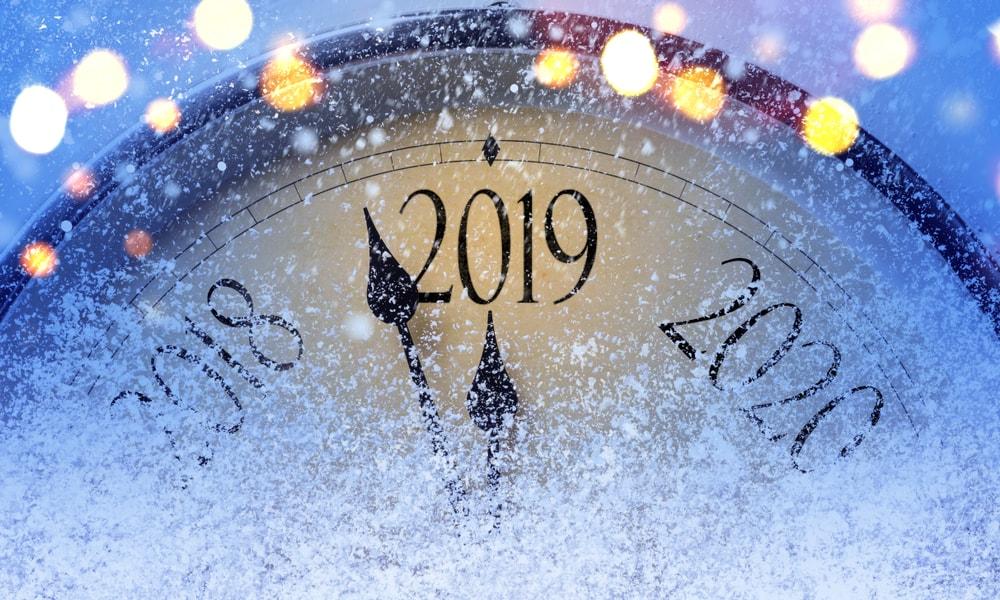19 Ways to Welcome the New Year

Your New Year’s Eve countdown parties perhaps consist of wearing something glittery, holding champagne flutes, and waiting for the clock to strike twelve and for the ball to drop in Times Square. And when it’s finally the New Year, you would alternately scream and blast party horns with light shows and fireworks in the background silhouetting everything. Meanwhile, other parts of the world are doing their own thing. Some of them may seem strange to us, from hurling ceramics to doors to slapping ice cream to floors.
Different cultures have different ways of ushering in the new year but with the same intent of cutting the cords of regret and negativity associated with the past year, at the same time being thankful for the wonderful blessings that came with it. New year’s rituals also focus on having a new year full of bounty and good fortune. And who doesn’t need an extra dose of luck?
As we welcome 2019, let’s explore 19 different ways cultures around the world celebrate the arrival of the new year. Who knows, you might even want to include some of them in your New Year’s Eve celebrations.
1. Fireworks
Fireworks on New Year’s Eve is a tradition shared by undoubtedly all people, though fireworks originated in China millennia ago. According to the Chinese, firecrackers, and fireworks on New Year’s Eve is a means to chase away evil spirits. Even though the Chinese celebrate the new year on a different date, based on the lunar calendar, the rest of the world incorporated fireworks to signal the arrival of the new Gregorian year.

2. Lentils
A New Year meal staple since the Roman times, lentils are considered lucky in countries like Brazil and Italy. Lentils resemble coins and are believed to bring good fortune and prosperity when eaten as part of the first meal of the new year.
3. Fried Balls
Doughnut-looking fried balls or Oliebollen are traditionally eaten on New Year’s Eve. Oliebollen are dumplings of dough with various delectable middles and dusted with confectioners’ sugar. They are thought to be a symbol of the year coming to full circle. And consuming them ensures success in the next.
4. 12 Grapes
In Spain and other countries with Spanish influence, it’s tradition to eat 12 grapes when the clock ticks 12 times at midnight. The 12 grapes symbolise 12 prosperous months to come. Some even insist that not only should 12 grapes be eaten but they should be consumed by the time the 12th chime of the clock ends. People who follow this tradition dare not miss one grape for fear of sabotaging their future.
5. Coin in Cake
If one is lucky during New Year Eve, they will bite into a cake and find a coin. Chipped toothed aside, Lady Luck is considered to be smiling upon them and will shower them with her blessings for the entire year. This Greek new year's traditional coin-bearing cake is called Vassilopitta.
6. Colored Undies
In Latin America, including some European countries like Spain and Italy, wearing colored underwear when the clock strikes midnight brings different fortunes depending on the underwear color. Yellow is said to bring financial gain. Red ensures a sizzling romance, white for peace and harmony, and blue or green for good health and wellness. Guess which color is the most popular? Yellow! Everyone wants more money and financial success. If one wears colored underwear that is gifted to them and worn inside out, then the effect is believed to be intensified.
7. Ice Cream
In Switzerland, people have ice cream not just to enjoy the rich flavors but to bring in a year of prosperity and good fortune as well. When midnight comes, scoops of ice cream get thrown on the floor for good luck. Children and adults enjoy this New Year’s Eve ritual. But their canine and feline friends enjoy this tradition the most! Slurping creamy, frozen delights on the floors is a wonderful way for them to start the new year.

8. Dots and Dots
In the Philippines, dots, circles, and all things round symbolise good fortune and prosperity. For an abundant year ahead, Filipinos serve meatballs and wear polka dots during New Year’s Eve. When the clock ticks midnight, Filipinos help ring in the new year by jingling loose coins in their pockets. Some would go further to leave coins all over their homes and scatter coins for people to catch. The more circles, the better!

9. Smashing Plates
In Greece, people traditionally smash plates on the floor as part of welcoming their new year celebration. In Denmark, this tradition is practiced with a twist. Instead of throwing plates on the floors, people hurl chinaware aimed at the doorsteps of friends and families. It says a lot of one’s popularity to find heaps of broken china by one’s door. Tradition says breaking dishes brings in good luck. The more smashed dishes you have to clean up, the more luck you’re getting.
10. 108 Peals
At midnight on December 31st, Buddhist temples in Japan ring their bells 108 times. According to their beliefs, 108 is the total number of temptations and desires that are keeping humanity in an endless cycle of suffering, lifetime after lifetime. It is thought that the ringing of bells 108 times can disentangle from the desires and sins of the year that just passed. It’s a form of spiritual housekeeping.
This tradition might not seem joyous but the Japanese ringing of bells on New Year’s Eve is indeed an enjoyable experience, so much so that people go to witness the event. It truly evokes feelings of a brand-new start.
11. Pomegranates
To countries such as Greece and Turkey, pomegranates hold the keys not only to a prosperous year ahead but also one that’s healthy and fertile. Pomegranates with their round seeds symbolise regeneration. People smash pomegranates, along with leftover anger and frustration of the year that just passed, on floors or doorsteps. The ones that hate to clean them up would use pomegranates as decorations.
12. Black-eyed Peas
No, not the band. Though having them hanging on New Year’s Eve parties would undoubtedly be smashing. In the Southern United States, one can’t escape black-eyed peas during New Year’s Eve. They are consumed alone or in a dish with rice and bell peppers called Hoppin’ John. Interestingly, when served on January 2, the day after the New Year, the dish is now called Skippin’ Jenny. Black-eyed peas, perhaps because of their resemblance to coins, is thought to bring prosperity and good luck for the coming year.
13. Lights On
In Latin America, Spain, and other countries with Spanish influence, such as the Philippines, turning on all the lights in all the rooms of the house is a must if one wants to welcome a bright future. Some traditions require all the lights to be turned off minutes before midnight and at the stroke of midnight, the lights are then all turned on.
14. Lug the Luggage
Running around the house or around the block with luggage in tow at midnight is a sure sign that the runner is wishing for some traveling to happen sometime in the coming year. In Colombia and other Hispanic cultures, running around with an empty suitcase is a must for the aspiring traveler. Now, it would be tricky to run around lugging an empty suitcase while munching 12 grapes at the stroke of midnight, but for sure, it has been done before.
15. Multiples Meals
Estonia’s New Year Eve celebration will make a person full, literally. It is common for people to have 7, 9 up to 12 meals on that day; 7, 9, and 12 being the lucky numbers. If there’s one day of the year that Estonians have permission to overindulge, this is it. It is thought that a person gains the strength of men corresponding to the number of meals partaken. Harnessed strength aside, eating these meals will allergy ensure a bountiful year. Some people do not eat everything on their plates because of another belief. A bit of food should be left on the plate for any ancestral spirits who might come to visit during New Year’s Eve.
16. Lantern Festivals
New Year’s Eve is a time to send prayers, wishes, and resolutions into the sky in Thailand. The Lantern Festival in Chang Mai is where people gather to light their lanterns, say their prayers, and release them at midnight. The sky will by then be full of lighted floating lanterns, each one carrying a petition for a wish to be granted within the following year. Lantern Festivals originated in China, although the Chinese light and release their lanterns during Lunar New Year.
17. 3-Day Celebrations
In Japan, the welcoming of the New Year is the most anticipated holiday of the year. It is very important that businesses close their doors from January 1 to January 3. This is the time for families to gather and celebrate.
New Year’s festivities is similarly celebrated in Scotland. Hogmanay is a three-day celebration beginning at the end of December, enjoyed up to the 2nd of January.
18. Sprinkle the Salt
When the new year bells ring, some people in Turkey open their front door and scatter salt on their doorstep. This ritual is thought to bring harmony and prosperity to homes and businesses.
Some European New Year’s Eve superstitions involve throwing salt over their shoulders, their left shoulders to be precise. Throwing and sprinkling salt during the new year is believed to reverse whatever bad luck has been acquired over the past year and encourage good fortune for the coming year.
19. Bang the Bread
Banging away bad luck with bread is a tradition in Ireland. Do away with bad luck and evil spirits; at the same time, welcome good luck and plenty of ‘bread’ over the coming year with a simple banging of bread against doors and walls. This tradition gives a pleasant new aspect to the term: bringing home the dough.
![]()
At BodyBlendz, we believe in shedding the old and bringing to light the new every day. The beginning of a new year is no exception. We celebrate it because a brand-new year gives us a fresh perspective; a whole new year ahead to glow and sparkle against whatever life throws at us. Here’s hoping all our lovely BodyBlendz babes around the world to have a wonderful and glowing 2019!
![]()
Lip Scrub
|
Vanilla Blush Coffee Scrub |












